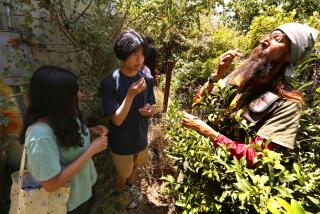Charter tackles middle school challenges with young faculties and a no-nonsense attitude
Eleazar and Nora Gonzalez decided to send their son Daniel to Lakeview Charter Academy because, they said, large public middle schools have a reputation for gangs and drugs. They also worried about academics.
So they warmed to the no-nonsense welcomings issued at the first monthly parents night.
“It will be a miracle the day I don’t give homework because home is to review,” Alexandra Aceves, 25, announced, in English and Spanish, to the Gonzalez family and others crowded into a second-floor classroom.
The scene exemplified the characteristics of the 10 schools operated by Partnerships to Uplift Communities, a locally based charter management organization that, like others in Los Angeles, has focused on serving low-income minority communities. It has taken on, in particular, the thorny challenge of middle schools, especially in the Latino neighborhoods of the San Fernando Valley and downtown.
PUC schools are notable for their young, inexperienced, yet consistently effective and close-knit faculties. Teachers develop their own curricula but follow a standardized lesson structure that incorporates high expectations for students and nonstop teacher training.
The Lake View Terrace school is among the Los Angeles Unified School District’s highest-scoring middle schools, even though 87% of its 316 students are low-income and more than half are English learners. Nearby Maclay Middle School in Pacoima, despite strong improvement this year, has proficiency rates less than half as high.
Lakeview’s message on that recent fall evening was repetitive: Students would be working hard, relentlessly. They would be closely watched. Extra help was available for all -- and mandatory for those who are struggling.
Second-year English teacher Araz Aboolian, 25, said she had to develop a yearlong course plan and submit weekly lessons to Principal Manuel Ponce, who provides immediate feedback.
A 31-year-old former PUC teacher, Ponce spends time every week with his 16 classroom instructors.
“A question he always asks is: ‘How are you going to measure that they’re actually learning?’ ” said Aboolian.
Classes begin with an exercise that reinforces recent learning. Teachers list goals for each period and later ask students whether the goals have been achieved.
“It was very challenging at first,” said seventh-grader Alejandra Figueroa, 12. “They expected a lot from us and I wasn’t used to that yet.”
In a recent eighth-grade algebra class, first-year teacher Christine Almasi explained how to use a T-shaped chart to simplify mathematical phrases. She answered questions and scanned for the less-engaged.
Three students had to return after class. She wanted to confirm a meeting with their parents. “I need you to come to tutoring every day after school,” she said. “If you don’t do that, you’re not going to pass this class.”
In the faculty meeting that afternoon, some of Almasi’s confidence abated.
“I call them in and talk to them, but if nothing happens, what do I do?” she asked.
Ponce later sent her some ideas. “We must always look at ourselves first,” he told his teachers. “First and foremost, we must find ways to support the student.”
More to Read
Sign up for Essential California
The most important California stories and recommendations in your inbox every morning.
You may occasionally receive promotional content from the Los Angeles Times.










